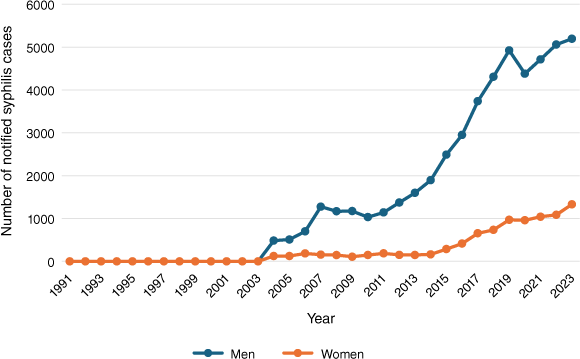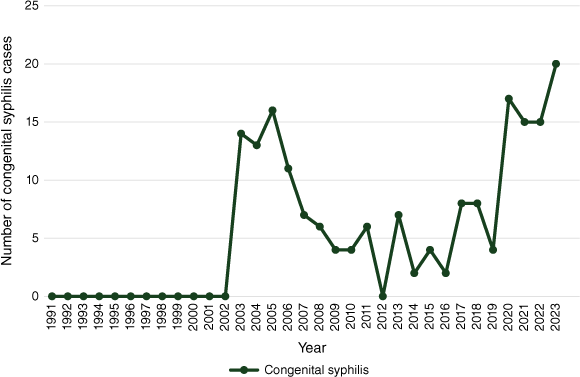Testing and capturing difficult-to-access populations for syphilis control in Australia
Ei T. Aung A B * and Eric P. F. Chow A B CA
B
C

Dr Ei Aung is a sexual health physician and research fellow at the Melbourne Sexual Health Centre (MSHC) and Monash University. She completed her PhD, with a focus on epidemiology and novel interventions for syphilis control, particularly Treponema pallidum testing from asymptomatic mucosal sites and anal self-examination for early detection of anal syphilis in men who have sex with men. |

Prof. Eric Chow is a sexually transmitted infections (STIs) epidemiologist and biostatistician at the MSHC and Monash University. His research program aims to improve the treatment, prevention and control of STIs, with a particular focus on gonorrhoea, syphilis and human papillomavirus. |
Abstract
Syphilis has significantly increased in the past decade in Australia, particularly among gay, bisexual and other men who have sex with men in urban areas, and Aboriginal and Torres Strait Islander peoples in regional and remote areas. Additionally, there has been a rise in cases among heterosexual men and women, including pregnant women, leading to a re-emergence of congenital syphilis. This resurgence underscores the ongoing need for effective public health interventions and innovative screening and detection methods. This article explores the epidemiology, screening and detection methods for syphilis, particularly focusing on difficult-to-access populations. Current screening strategies, including serology and molecular assays and recent changes in antenatal screening guidelines to prevent congenital syphilis are discussed. The article highlights the need for innovative, patient-centred detection methods and tailored interventions. New early detection methods, such as improved rapid diagnostic tests and digital health solutions, are discussed for their potential to increase screening uptake and early diagnosis. The findings underscore the importance of a multidisciplinary approach in syphilis control, combining universal and targeted interventions to effectively reduce transmission and improve public health outcomes.
Keywords: epidemiology, methods of syphilis detection, screening, sexually transmitted infections, STIs, syphilis, syphilis control, Treponema pallidum.
Background
Syphilis is an infectious disease caused by the spirochete Treponema pallidum. This bacterium elicits a local inflammatory response by replicating within tissues at the site of exposure or at other organs and sites distant from the exposure site, resulting in varied clinical presentations.1 Transmission is predominantly through sexual contact although it can be transmitted through blood transfusions or vertically.2 Syphilis is infectious during early stages of infection and sexual transmission risk is estimated to be as high as 50%.2,3 Vertical transmission from mother to foetus can result in adverse birth outcomes and congenital syphilis, which is a severe, disabling and life-threatening infection in infants. If left untreated in an infected individual, syphilis can lead to serious health issues such as neurological damage, heart disease, blindness and even death.4
Epidemiology
Syphilis continues to cause a significant burden globally. According to the World Health Organization, 7.1 million adults were newly infected with syphilis worldwide in 2020, with an estimated high burden of foetal deaths, stillbirths and preterm births due to syphilis.5 In Australia, the annual number of notifications of infectious syphilis has more than tripled during the past decade, from 1719 notifications in 2013 to 6036 in 20226 (Fig. 1). Similar rises have been reported in other high-income countries such as Canada, the UK, the USA and some European countries.5
Notifications of syphilis cases in Australian men and women, 1991–2023. Source: Department of Health and Aged Care – National Communicable Disease Surveillance Dashboard.34

The notification of syphilis in Australia has been the highest among men who have sex with men (MSM) in urban cities and Aboriginal and Torres Strait Islander peoples in regional and remote areas.7 However, in the past decade, an increase was reported in the notification of infectious syphilis cases among heterosexual men and women, especially those of child-bearing age, living in lower socioeconomic areas and women pregnant at the time of diagnosis.3,7,8 Furthermore, the transmission dynamics between sexual networks of MSM and heterosexual men and women are not well understood.
A previous Australian whole genome sequencing study revealed that most T. pallidum lineages were associated with MSM, except one subgroup is linked to heterosexuals.9 This aligns with a UK study that showed distinct MSM and heterosexual clusters, while also indicating possible bridging between MSM and heterosexuals through sexual mixing.10
Screening and early detection
Early detection and prompt treatment are essential in syphilis control and intervention to prevent serious health problems and reduce transmission. Although promoting safe sex practices including condom use and raising awareness about syphilis through public health campaigns and education are important, they may not be successful in the long run. A decline in condom use, along with an increase in rates of sexually transmitted infections (STIs) including syphilis, has been reported among MSM taking human immunodeficiency virus (HIV) pre-exposure prophylaxis (PrEP).11 Regular screening and timely healthcare-seeking after the onset of signs and symptoms might be one of the best options to detect syphilis infection early. However, new innovative methods are urgently needed that are patient centred and helpful in clinical settings for the early detection of syphilis. These methods include direct detection molecular assays or point-of-care (POC) tests that can identify active infections, as well as serology tests that can distinguish between early infections and late latent infections. Moreover, it is important to tailor interventions to the targeted populations. Since bridging between the transmission networks of MSM and heterosexual populations may play a role in sustaining infections, interventions should address these bridging groups to effectively reduce transmission.
Screening for syphilis – existing and emerging strategies
Incorporating universal syphilis screening in routine antenatal tests, similar to HIV and hepatitis screening in pregnancy, is a measure to detect syphilis in pregnancy.3 The increase in syphilis cases among women of reproductive age is of great concern, as it is associated with congenital syphilis and other pregnancy complications without treatment. Already, there were 93 cases of congenital syphilis reported in 2016–2024 in Australia12 (Fig. 2). In the first quarter of 2024, 13% of Aboriginal and Torres Strait Islander women and 16% of non-Indigenous women diagnosed with syphilis were pregnant at the time of diagnosis.12 Current Australia Pregnancy Care Guidelines recommend universal syphilis testing at the first antenatal visit with additional risk-based syphilis testing at 28–32 weeks’ gestation (3rd trimester) and at delivery.13 However, a study by Wigan et al. reported difficulties with risk-based syphilis testing in later pregnancy, such as lack of knowledge or confidence for risk assessment by clinicians and midwives involved in antenatal care.14 New South Wales, Western Australia and Queensland have recommended a second universal screening at 26–28 weeks’ gestation instead of risk-based testing.
Congenital syphilis cases in Australia, 1991–2023. Source: Department of Health and Aged Care – National Communicable Disease Surveillance Dashboard.34

Current Australian STI guidelines recommend routine 3-monthly syphilis screen for sexually active MSM, including those taking HIV PrEP.15 A past study has shown that frequent syphilis screening in MSM has reduced the detection of secondary syphilis cases and increased detection of asymptomatic early latent syphilis.16 Similarly, opt-out syphilis testing strategies have been shown to increase syphilis testing in other populations, including women and people living with HIV.17
Barriers to attending clinics for syphilis screening include costs, distance to clinics, lack of suitable opening hours, fear of positive results, embarrassment and shame, and perceived notion of testing only when symptoms develop.18 Digital health for HIV and STI testing has been viewed as a way to overcome these barriers and increase uptake of HIV and STI testing. Online STI services include (1) online postal self-sampling that requires self-collection of samples and posting them to the pathology centre, (2) self-testing that involves a person self-collecting and testing their own sample and interpreting the results, or (3) ordering the tests online and presenting to the pathology centre to undergo testing.19 A meta-analysis showed self-sampling for STI tests including syphilis increased uptake by 1.7 times compared with facility-based testing.19 This method has the potential to reach underserved populations and could be valuable as an additional testing approach. Nonetheless, online STI services in Australia are not well-regulated and a systematic review of web-based HIV and STI testing services in Australia reported variable quality, standards and costs of these services with higher quality in government funded services.20 Moreover, web-based STI services using direct to pathology testing raised concerns over stigma experienced by some clients at the pathology collection centres. Potentially, negative experiences could be a barrier HIV and STI testing in remote and regional areas with privacy concerns in small communities. Digital vending machines that distribute HIV self-test and STI self-sample kits and use postal services for specimen return have been shown to be acceptable and are currently being piloted in remote and regional communities in Victoria.21
Methods of syphilis detection
Traditionally, syphilis detection is relied on serology, which is the gold-standard method for syphilis diagnosis. It has the disadvantage of returning false-negative results in the very early stage of infection using both traditional and reverse algorithms in syphilis screening. The US Centers for Disease Control and Prevention (CDC) recommends using a combination of both nontreponemal and treponemal tests when a primary test is reactive to avoid misclassifying a person’s syphilis status.22 The development of antibodies can take up to 2–4 weeks after primary infection with T. pallidum.22
Newer diagnostic methods using molecular assays such as polymerase chain reaction (PCR) for detection of T. pallidum have been used for diagnostic purposes, and are useful among people presenting with symptoms due to high sensitivity and specificity (respectively ranging from 72 to 95% and 98 to 100% depending on the assay method and stages of syphilis) in detecting T. pallidum from lesion samples.22 Several studies have examined the use of molecular methods in syphilis screening, particularly in MSM taking HIV PrEP in the last decade.23,24 A Dutch study by Zondag et al. added T. pallidum transcription medicated amplification (TP-TMA) assay to routine anal, pharyngeal and urine samples for chlamydia and gonorrhoea screening among PrEP users and the study identified 7% (14 out of 191) additional syphilis infections, suggesting that TP-TMA assay may be a useful tool to identify early syphilis cases.23 However, a similar Australian study by Aung et al. did not show additional benefit when anal and pharyngeal samples were tested with a T. pallidum PCR (TP-PCR) assay among MSM taking PrEP.24 In their study, there were no positive PCR samples when serology was negative.24 The study was, however, limited by the sample size and a lower sensitivity of the TP-PCR assay compared to the TP-TMA assay. Taken together, the usefulness of direct detection of syphilis using molecular assays for screening is inconclusive and further studies are required to assess the cost effectiveness.
Nevertheless, a molecular assay might be useful in distinguishing stages of syphilis infection, an important step in deciding on the required number of penicillin injections. This is particularly relevant due to the global shortage of benzathine benzylpenicillin and the unavailability of some diagnostic serology tests, such as the T. pallidum particle agglutination (TPPA) test. Another study by Aung et al. examined the PCR detection of T. pallidum in self-reported syphilis contacts and it showed PCR detection from multiple samples at asymptomatic sites in men and women.25 Similar findings were reported in a number of studies which examined the detection of syphilis by TMA and PCR from various samples in people with confirmed syphilis. These findings show that PCR or TMA may be able to help distinguish between early and late syphilis in asymptomatic people with syphilis. This is clinically important because it is often challenging to stage early or late syphilis without primary or secondary symptoms and without previous serology. Detection of T. pallidum from mucosal sites by PCR or TMA indicates possible early syphilis, which would require fewer penicillin injections.
In Australia, PCR is the commonly used molecular assay for syphilis diagnosis and often, it is an in-house laboratory assay as there are limited commercial assays available. A Melbourne group conducted a study using multiplex PCR testing of anogenital lesions for T. pallidum and herpes simplex virus (HSV) in primary care setting. They partnered with a commercial company and a for-profit laboratory to perform T. pallidum PCR on specimens initially requesting HSV testing.26 Preliminary results indicated that 26% (22 out of 86) of T. pallidum-positive samples came from patients who were only tested for HSV.26 The findings reflect that syphilis is likely to be more prevalent in the community than reported.
In resource limited settings, rapid POC tests have the potential to increase testing and provide an opportunity to offer treatment immediately during the same consultation.27 Syphilis POC testing has been supported in resource-limited settings, including remote rural settings in Australia. Currently, only one syphilis POC test, the Determine Syphilis TP manufactured by Abbott, has been registered by the Therapeutic Goods Administration (TGA) in Australia and it has an overall sensitivity of 97% and specificity of 96%.27
Although syphilis POC tests have a role in syphilis control programs in certain settings, the lower sensitivities in some of the commercially available POC tests compared to conventional serology suggest additional tests are required in key populations to avoid missing early syphilis.27,28 Moreover, POC tests are unable to differentiate between active and past-treated infection,28 rendering them ineffective for populations with high rates of syphilis reinfections. There are newer POC tests that might be able to identify active infection, but they are still under development.
Future directions
Doxycycline as a post-exposure prophylaxis (doxy-PEP) for preventing bacterial STI has been shown to be effective in reducing syphilis infections in MSM.29,30 In a doxy-PEP randomised controlled trial of 500 men, the combined incidence of chlamydia, gonorrhoea and syphilis were lower by two-thirds in the doxycycline group and the relative risk reduction for syphilis in the doxycycline prophylaxis group was 0.13 (95% CI, 0.03 to 0.59).29 However, these studies focused on MSM, and more research is needed for women using doxy-PEP for syphilis prevention in relation to safety and effectiveness.31 Although doxy-PEP is a potentially effective biomedical prevention for syphilis, particularly in at-risk populations, it is important to take into consideration an equally important issue of antimicrobial stewardship when prescribing doxy-PEP and its potential effect on the gut microbiome with frequent long-term usage.32 Vaccines for syphilis are the ultimate goal in syphilis prevention and control due to their potential to provide long term immunity and mass protection at the population level without affecting antimicrobial resistance. Despite some progress on vaccine research, a suitable candidate is still far away.33
Prevention and control of syphilis
Effective syphilis control requires a multidisciplinary approach including policymakers, health professionals from public health, sexual health, primary care, infectious diseases fields, laboratories and commercial partners for diagnostics and community organisations. Improving access to sexual health services for HIV and STI testing and treatment is a key factor in syphilis control, and this requires dedicated funding for the provision of services to the community. Ongoing public health interventions such as health promotion, ensuring the availability of condoms in events and venues for key populations, accessibility to HIV and STI testing and treatment where people can feel safe without stigma, and contact tracing to minimise further transmission should be maintained.
Personal perspective
In summary, we recommend additional universal syphilis testing in later pregnancy to ensure no antenatal syphilis cases are missed and timely interventions can be made. Tailored interventions based on the characteristics of specific populations are likely to be more effective than universal control measures. Nonetheless, we also acknowledge the role of universal control measures in syphilis control, advocating for a combination of both universal and targeted interventions.
Declaration of funding
Eric P. F. Chow is supported by the National Health and Medical Research Council (NHMRC) Emerging Leadership Investigator Grant (GNT1172873).
References
1 Peeling RW et al. (2017) Syphilis. Nat Rev Dis Primers 3, 17073.
| Crossref | Google Scholar | PubMed |
2 Stoltey JE, Cohen SE (2015) Syphilis transmission: a review of the current evidence. Sex Health 12, 103-109.
| Crossref | Google Scholar | PubMed |
3 Carter A et al. (2023) Infectious syphilis in women and heterosexual men in major Australian cities: sentinel surveillance data, 2011–2019. Med J Aust 218, 223-228.
| Crossref | Google Scholar | PubMed |
5 Kojima N, Klausner JD (2018) An update on the global epidemiology of syphilis. Curr Epidemiol Rep 5, 24-38.
| Crossref | Google Scholar | PubMed |
6 King J et al. (2023) HIV, viral hepatitis and sexually transmissible infections in Australia: Annual surveillance report 2023. The Kirby Institute, UNSW Sydney, Sydney, NSW, Australia. 10.26190/f5ph-f972
7 Kirby Institute (2021) HIV, viral hepatitis and sexually transmissible infections in Australia: annual surveillance report 2021. The Kirby Institute, UNSW Sydney, Sydney, NSW, Australia. https://www.kirby.unsw.edu.au/research/reports/asr2021
8 Aung ET et al. (2021) Spatial and temporal epidemiology of infectious syphilis in Victoria, Australia, 2015-2018. Sex Transm Dis 48, e178-e182.
| Crossref | Google Scholar | PubMed |
9 Taouk ML et al. (2022) Characterisation of Treponema pallidum lineages within the contemporary syphilis outbreak in Australia: a genomic epidemiological analysis. Lancet Microbe 3, e417-e426.
| Crossref | Google Scholar | PubMed |
10 Beale MA et al. (2023) Genomic epidemiology of syphilis in England: a population-based study. Lancet Microbe 4, e770-e780.
| Crossref | Google Scholar | PubMed |
11 Traeger MW et al. (2018) Effects of pre-exposure prophylaxis for the prevention of human immunodeficiency virus infection on sexual risk behavior in men who have sex with men: a systematic review and meta-analysis. Clin Infect Dis 67, 676-686.
| Crossref | Google Scholar | PubMed |
12 Australian Government Department of Health Australian Centre for Disease Control (2024). National syphilis surveillance quarterly report – January to March 2024. Commonwealth of Australia. https://www.health.gov.au/resources/publications/national-syphilis-surveillance-quarterly-report-january-to-march-2024?language=en
13 Australian Government Department of Health and Aged Care (2024) Australia Pregnancy Care Guideline (Version 3.0). Australian Living Evidence Collaboration, Melbourne, Vic., Australia. https://app.magicapp.org/#/guideline/jm83RE
14 Wigan R et al. (2024) Is risk-based screening for syphilis in later pregnancy a realistic approach? Int J STD AIDS 35(IS), 24-25 [Abstract N1].
| Crossref | Google Scholar |
15 Ong JJ et al. (2023) Australian sexually transmitted infection (STI) management guidelines for use in primary care 2022 update. Sex Health 20, 1-8.
| Crossref | Google Scholar | PubMed |
16 Chow EPF et al. (2017) Increased syphilis testing of men who have sex with men: greater detection of asymptomatic early syphilis and relative reduction in secondary syphilis. Clin Infect Dis 65, 389-395.
| Crossref | Google Scholar | PubMed |
17 Gupta P et al. (2023) Increased syphilis testing and detection of late latent syphilis among women after switching from risk-based to opt-out testing strategy in an urban Australian sexual health clinic: a retrospective observational study. Lancet Reg Health West Pac 40, 100875.
| Crossref | Google Scholar | PubMed |
18 Aung ET et al. (2022) Exploring the use of “nudges” to improve HIV and other sexually transmitted infection testing among men who have sex with men. Arch Sex Behav 51, 2641-2650.
| Crossref | Google Scholar | PubMed |
19 Kpokiri EE et al. (2020) Diagnostic infectious diseases testing outside clinics: a global systematic review and meta-analysis. Open Forum Infect Dis 7, ofaa360.
| Crossref | Google Scholar | PubMed |
20 Cardwell ET et al. (2023) Web-based STI/HIV testing services available for access in Australia: systematic search and analysis. J Med Internet Res 25, e45695.
| Crossref | Google Scholar | PubMed |
21 Evans D et al. (2024) STI-X: a novel approach to STI testing in rural and regional Victoria, Australia. Sex Health 21, SH23118.
| Crossref | Google Scholar | PubMed |
22 Papp JR et al. (2024) CDC laboratory recommendations for syphilis testing, United States, 2024. MMWR Recomm Rep 73, 1-32.
| Crossref | Google Scholar | PubMed |
23 Zondag HCA et al. (2023) Timely diagnosis of incubating syphilis infections using Treponema pallidum transcription-mediated amplification assay. Clin Infect Dis 77, 1717-1722.
| Crossref | Google Scholar | PubMed |
24 Aung ET et al. (2023) Treponema pallidum PCR screening at mucosal sites of asymptomatic men who have sex with men taking HIV pre-exposure prophylaxis. Microbiol Spectr 11, e0079423.
| Crossref | Google Scholar | PubMed |
25 Aung ET et al. (2023) Treponema pallidum detection at asymptomatic oral, anal, and vaginal sites in adults reporting sexual contact with persons with syphilis. Emerg Infect Dis 29, 2083-2092.
| Crossref | Google Scholar | PubMed |
26 Wigan R et al. (2024) Multiplex PCR testing of anogenital lesions for Treponema pallidum and herpes simplex virus in primary care improves the detection of primary syphilis. Int J STD AIDS 35(IS), 120-121 [Abstract P0140].
| Crossref | Google Scholar |
27 Causer LM et al. (2014) A laboratory-based evaluation of four rapid point-of-care tests for syphilis. PLoS One 9, e91504.
| Crossref | Google Scholar | PubMed |
28 Towns JM et al. (2023) The role of syphilis self-testing as an additional syphilis testing approach in key populations: a systematic review and meta-analysis. The Lancet Public Health 8, e726-e734.
| Crossref | Google Scholar | PubMed |
29 Luetkemeyer AF et al. (2023) Postexposure doxycycline to prevent bacterial sexually transmitted infections. N Engl J Med 388, 1296-1306.
| Crossref | Google Scholar | PubMed |
30 Molina J-M et al. (2024) Doxycycline prophylaxis and meningococcal group B vaccine to prevent bacterial sexually transmitted infections in France (ANRS 174 DOXYVAC): a multicentre, open-label, randomised trial with a 2 x 2 factorial design. Lancet Infect Dis
| Crossref | Google Scholar | PubMed |
31 Stewart J et al. (2023) Doxycycline prophylaxis to prevent sexually transmitted infections in women. N Engl J Med 389, 2331-2340.
| Crossref | Google Scholar | PubMed |
32 Bell SFE et al. (2024) Response to the ASHM 2023 statement on the use of doxy-PEP in Australia: considerations and recommendations. Med J Aust 220, 356-360.
| Crossref | Google Scholar | PubMed |
33 Lukehart SA et al. (2022) Immunization with a tri-antigen syphilis vaccine significantly attenuates chancre development, reduces bacterial load, and inhibits dissemination of Treponema pallidum. Vaccine 40, 7676-7692.
| Crossref | Google Scholar | PubMed |
34 Australian Government Department of Health and Aged Care (2024) National Notifiable Disease Surveillance System. Nation Communicable Disease Surveillance Dashboard. Commonwealth of Australia.https://nindss.health.gov.au/pbi-dashboard/ [Verified 5 August 2024]
 Dr Ei Aung is a sexual health physician and research fellow at the Melbourne Sexual Health Centre (MSHC) and Monash University. She completed her PhD, with a focus on epidemiology and novel interventions for syphilis control, particularly Treponema pallidum testing from asymptomatic mucosal sites and anal self-examination for early detection of anal syphilis in men who have sex with men. |
 Prof. Eric Chow is a sexually transmitted infections (STIs) epidemiologist and biostatistician at the MSHC and Monash University. His research program aims to improve the treatment, prevention and control of STIs, with a particular focus on gonorrhoea, syphilis and human papillomavirus. |


